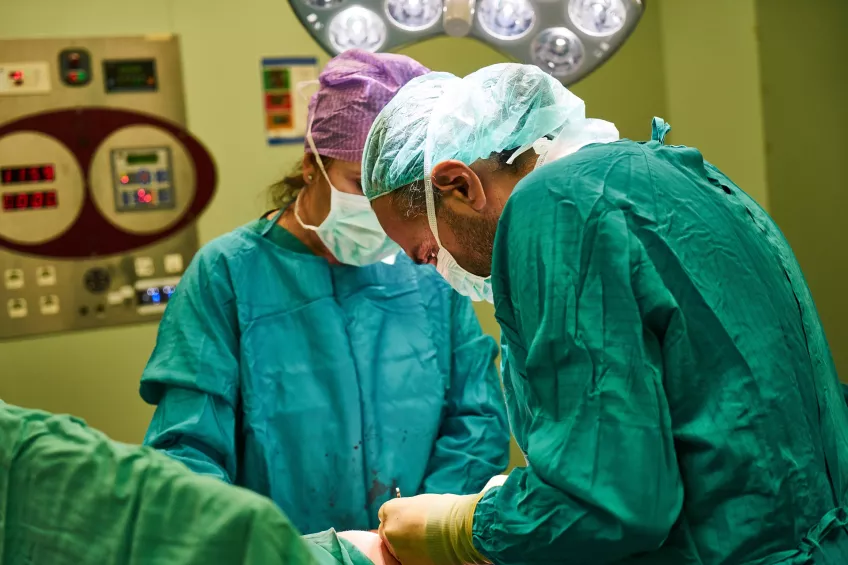Other joint surgeries
Apart from arthroplasty, other surgical procedures can be performed on osteoarthritis-affected joints. Which procedure is most appropriate largely depends on the joint affected.
Despite joint replacement surgery being the most commonly performed surgery on people with osteoarthritis (OA), other OA-affected joints such as the big toe or wrist may also require some form of surgery. If other treatment methods haven’t provided sufficient symptom relief, i.e. severe pain and reduced range of movement in the joint still prevail, surgery may be considered.
Ankle
In severe OA of the ankle, joint fusion surgery (arthrodesis) is the most common surgical procedure. Joint fusion entails removing the damaged articular cartilage and inserting small pieces of bone between the joint surfaces. The bones are then held together by some sort of connective hardware. This is done so that the bones eventually fuse together. The ankle is placed in a fixed position, which provides the foot with stability and relieves pain. However, the procedure can lead to a loss of ankle mobility. The ankle joint may also be replaced with an artificial joint. Ankle arthroplasty does not affect ankle mobility in the same way as joint fusion surgery does, but prosthetic components may loosen over time, creating instability of the foot.
Big toe
The most common surgical procedure for an OA-affected big toe involves removing bone spurs and/or part of the dorsal metatarsal head. This procedure is known as a cheilectomy. Removing excess bone reduces joint stiffness and pain. In some cases, a doctor may choose to perform joint fusion surgery instead.
The base of the thumb
There are several ways to operate the thumb's basal joint. The most common surgical procedure for OA of the base of the thumb is the removal of one of the bones in the base of the thumb (the trapezium). This is known as a Trapeziectomy. The bone is replaced with a piece of tendon from the wrist or a prosthesis made out of silicone to maintain stability and mobility in the thumbs basal joint. An arthrodesis (joint fusion) may also be performed but is not preferred as it significantly affects the mobility of the thumb.
Fingers and wrist
In OA of the fingers or the wrist, the surgeon will often choose to remove one or more bones in the affected joint (common for wrist OA) or perform joint fusion surgery (common for finger OA). If severe OA is present in a joint at the base of the finger or the middle of the finger, the joint may be replaced with a prosthesis. Most hand surgery procedures can be performed under local anesthesia.
Shoulder
It is unusual to operate on an OA-affected shoulder, but if shoulder OA is badly affecting shoulder mobility and causing severe pain, the affected shoulder joint may be replaced with a prosthesis. If the glenohumeral joint is affected, the shoulder head is replaced with a metal ball. The joint socket may also be replaced with a plastic cup.
Spine
Surgical treatment for OA of the spine is generally not recommended as results are often not satisfactory and the risk of complications is relatively high. In severe cases of spinal OA, spinal fusion may be performed in specific areas of the spine to reduce pain. However, spinal OA tends to affect several of the small bones of the spine (vertebrae) and operating on large areas substantially limits spinal motion. The spine is designed to move and therefore spinal fusion should be performed with great care and only between a very small number of vertebrae.
Jaw
The temporomandibular joint (TMJ) is the joint that allows the jaw to move up and down. TMJ surgery is very uncommon and it tends to be the last resort for people suffering from OA of the jaw. However, surgery may be necessary if it becomes increasingly difficult to open the mouth or if the jaw continuously locks. Before deciding to perform open-joint surgery (in which the disc in the jaw is replaced or repaired), the surgeon often performs an arthroscopy to remove scar tissue and cartilage and reshape the jawbone.
Surgery may be considered when other treatment methods haven't had satisfactory results. Most people experience great pain relief and improved quality of life after surgery. However, it is important to keep in mind that no surgery is without risk.


